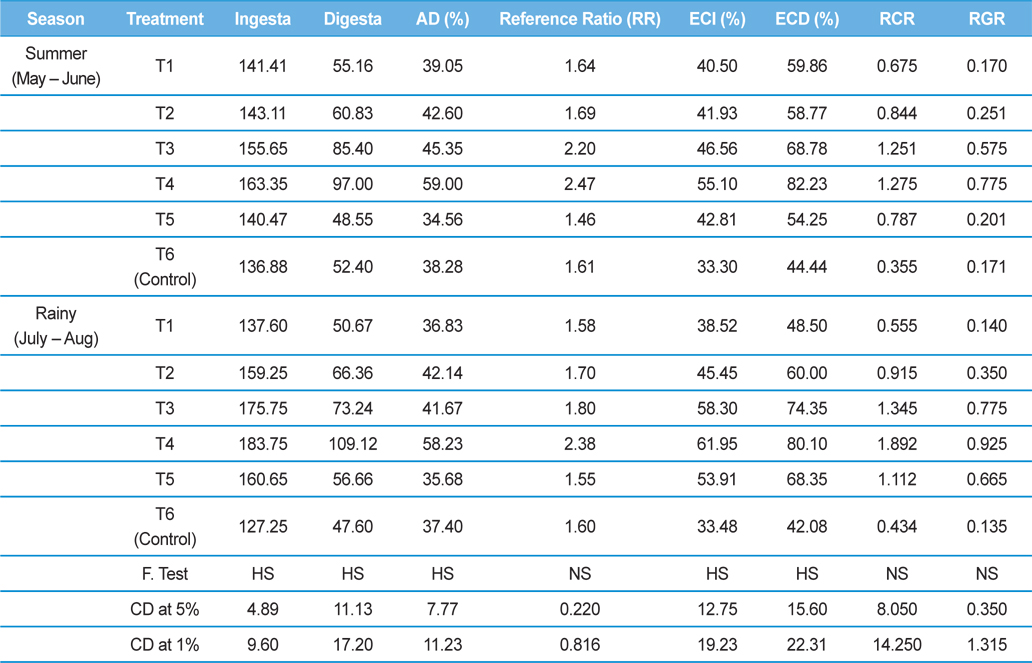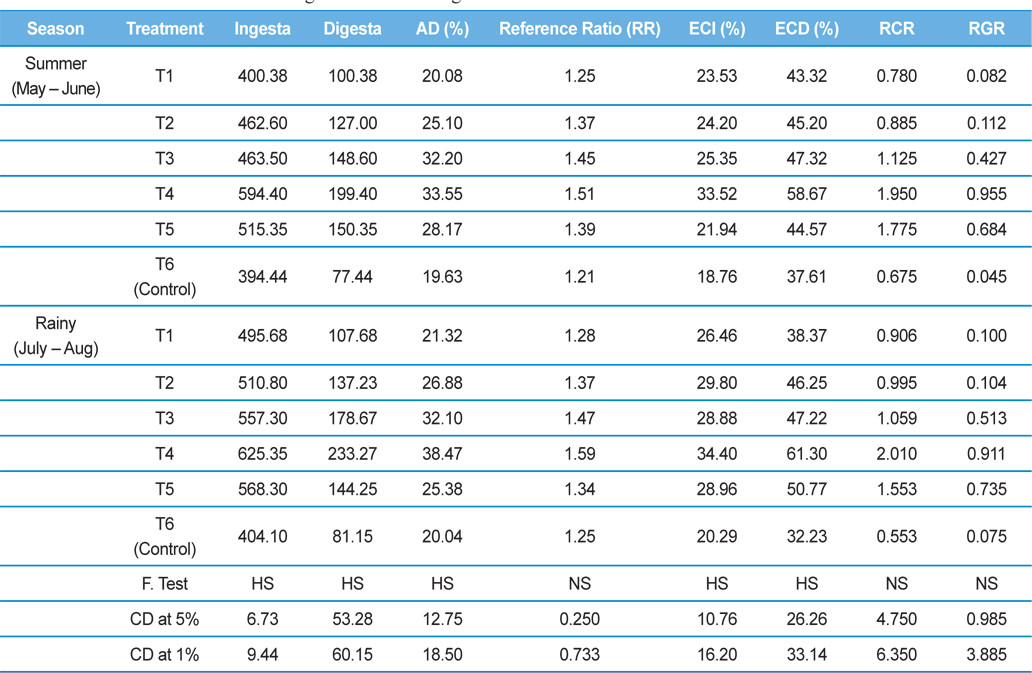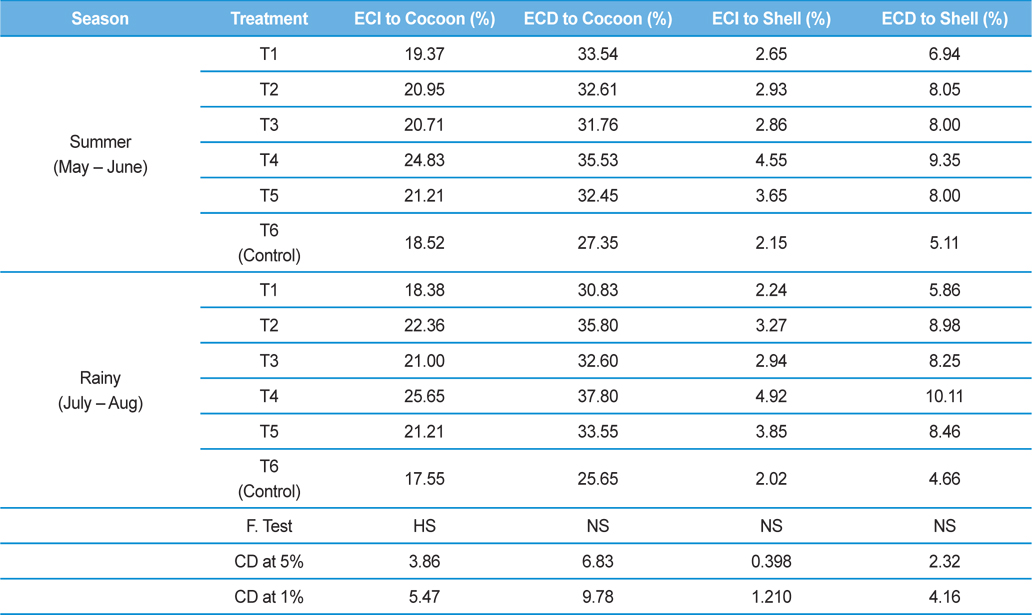Sericulture has been a traditional rural industry and instrumental in poverty alleviation in India. Qualitative and quantitative increase of cocoon production would certainly result into better economics for this industry and meet production needs. In order to increase the cocoon production, enrichment of mulberry leaves by supplementary compounds is an absolute important aspect (Etebari et al., 2004). Nutritional supplements when added to normal food, not only tend to increase the nutritional value of the food but improves also the vital parameters of the silkworm also (Bajpeyi et al., 1991).
Probiotics are the live microbial feed supplements which beneficially affect the host by improving the microbial balance (Yeung et al., 2002). The microbes, Lactobacilli and Bifidobacteria, are gram + ve bacteria producing lactic acid and extensively studied to improve cocoon characters in B.mori L (Masthan et al., 2010). Oral administration of mulberry leaf and castor leaf supplemented with single cell protein ‘spirulina’ (Blue green algae) as a feed to respective silkworms Bombyx mori L (Venkataramana et al., 2003) and Samia cynthia ricini Boisduval (Jayaprakash et al., 2005) was found to be effective in enhancing the larval and cocoon characters in mulberry silk worm. The antiviral protein of spirulina platensis exhibited 90% resistance to BmNPV of B.mori L (Babu et al., 2005).
Cyanobacteria (Blue green algae) are free living photosynthetic, and N2 fixing bacteria found in fresh, marine water and terrestrial environments. Genus Anabaena having 40 common species store reserve food materials which can be utilized as a source of proteins, lipids, vitamins and secondary metabolites (Anupama, 2000 and Tan, 2007). The antibiotic and nutritious effects of Anabaena variabilis cyanobacteria (Sampath et al., 2013) were evidenced by increased larval weights and cocoon yield of eri silkworm S.ricini Boisduval when they fed with castor leaves fortified with A.variabilis aqueous extracts. However, information on the synergistic action of combination of feed supplements is very scanty. Hence, the present investigation was undertaken to study the effect of cyanobacteria, A.variabilis as feed supplement on consumption, utilization and commercial indices of eri silkworm, Samia ricini Donovam.
Eri silkworm S ricini Donovan (Saturniidae: Lepidoptera) was selected for utilization studies because of their hardiness and less susceptibility to diseases. Leaves of primary host plant, Ricinus communis Lin (castor) were preferred as the source of food for the test insect which is next to host plant, Kessuru, Heteropanax fragrans (Roxb.) Seem, with respect to nutritional status of the host plant. Evaluation of food consumption and utilization in this insect was successfully undertaken as it is reared indoors like mulberry silkworm B. mori L.
Cyanobacteria, A. variabilis strains selected as feed supplements and obtained from growing cultures of rice fields of Warangal district, Andhra Pradesh, India. These cultures were subcultured in BC-II media with or without nitrogenous source at 25±1℃ temperature under continuous illumination (3000 lux) for 12 d. Then, the culture was washed with distilled water (Sampath et al., 2013) to obtain pellets which were shade dried at room temperature.
Tray-cum shelf rearing method with 25 eri silkworm disease free layings (DFLs) were carried out on castor leaves as suggested by Jayaprakash et al. (2006) in rearing chambers under controlled (temp. 25 - 26℃ and relative humidity 85%) conditions.
Feed utilization studies were confined to 4th and 5th instar eri silkworm larvae as 80% of total leaves was consumed in these instars. Since resumption to 4th instar, 60 larvae each in four replications (irrespective of sex) of a treatment were maintained separately from general rearing.
Aqueous solution of A.variabilis at 100 ppm (T1), 200 ppm (T2), 300 ppm (T3), 400 ppm (T4), 500 ppm (T5) concentrations and control (T6) with distilled water were prepared daily for soaking of castor leaves for 20 min each treatment. Soaked leaves were shade dried and fed to worms daily four times at an interval of 6 h. Each treated castor leaf was cut into two halves one half was fed to the larvae while the other half was usied for the dry weight determination. Additional larval batch of each treatment was also maintained to determine the dry weight and for subsequent determination of daily increment in larval weight. The feeding duration of 4th and 5th instar larvae was also noted. The healthy larvae were counted daily, unequal, or dead and missing larvae were replaced with larvae of same age group from additional batches. Leaves and faeces were collected at 10 A.M daily and dried in an oven at 80℃ to a constant weight. Thus, for each day of feeding period, dry matter ingested, digested, faeces produced and increase in larval weight was recorded daily.
The nutritional indices viz., ingesta, digesta, approximate digestibility (AD%), reference ratio (PR) and nutritional efficiency parameters viz., efficiency of converting the ingesta (ECI) and digesta (ECD) into larva, cocoon and shell weight were calculated. Besides, relative consumption and growth rates (RCR & RGR) were computed. The methods of calculation of various parameters (Mathur et al., 2002 and Rath, 2011) were as follows:
The experiments were repeated twice during summer and rainy seasons of 2013 year and pooled data were tabulated, compiled and analyzed by using ANOVA (Analysis of Variance) test.
The food consumption, utilization efficiencies and growth rates of 4th and 5th instars are presented in Table 1 and 2, respectively. The amount of ingesta and digesta varied significantly in 4th and 5th instar larvae fed with castor, R. communis, leaves treated with different concentrations of A.variabilis and in different seasons. The amount of food consumed and digested was significantly high in both the batches fed on castor leaves treated with 400 ppm (T4) of cyanobacteria during summer and rainy seasons. Descending order of values in ingestion and digestion capacity of 4th instar larvae was observed at 300 (T3), 200 (T2), 500 (T5), 100 (T1) ppm concentration of A.variabilis whereas in 5th instar it was at T5, T3, T2 and T1 concentrations in both the seasons. Significantly low ingesta and digesta was recorded in control (T6) treatments of both larval instars. The findings of Horie et al. (1976), Jaksheva and Genova (1991), Anantha Raman et al. (1993), Mathur et al. (2002) and Gokulamma and Reddy (2005) had supported the present findings by revealing the higher ingesta and digesta values for 4th and 5th instars of B. mori L. The higher ingesta in 5th instar is necessary as the larvae has to maintain metabolic demand during the transformation stages from larvae to pupa, pupa to moth. Similar results were also reported by Poonia (1978), Reddy and Alfred (1979) in eri silkworm Philosamia ricini and Rana et al. (1987) in Oak tasar silkworm, Antheraea proylei Jolly. Larval weight of eri silkworm has increased substantially (Tomy Philip et al., 2009) when the larvae from 3rd instar to spinning stage were fed on castor foliage fortified with leaf extracts of Stachytarpheta indica (L) Vahl.
Sampath et al. (2013) observed increase in larval weight (59.95%), pupation rate (31.83%) and cocoon yield (146.86%) of S.C ricini Boisduval fed on castor leaves foliated with 500 ppm of A. variabilis aqueous extracts. Higher cocoon yield of S.C. ricini might be attributed to reduction in larval mortality effected by antibacterial and antiviral activities of cyanobacteria, A.variabilis (Bloor and England, 1989).
The approximate digestibility (AD) defines the quantity of food that was actually digested. AD gradually increased in the treated batches 1 to 4th instar when compared to 5th instar larvae during summer and rainy seasons. significant difference of AD% between control and other treatments batches was noticed (Table 1 &2). This is probably dur to feeding of larvae on supplemented nutrients along with castor leaves. The digestibility is affected by high content of crued fiber deficiency of nutriunts and water in food (Waldbauer, 1964). Similar results of AD as per the age of worms were also reported by Poonia (1978) and Rana et al. (1987).
Reference ratio (RR) expresses ingesta required per unit excreta production. High value of RR indicates high rate of digestion and absorption of food. It also expresses the retention efficiency of food. comparatively higher RR (Table 1) was recorded in 400 ppm (T4) treatment(2.47)(2.38) batches than control (1.61) and (1.60) batches of 4th instar larvae recpectively during the both seasons. It indicates that 4th instar larva has to ingest more to produce one gram of excreta. Gokulamma and Reddy (2005) reported that RR and AD (%) values were high during early instars and reduced with advancement of instars of B.mori L. (Table 1 and 2)
Efficiency conversion of ingested food (ECI) is an overall measure of the ability of larvae to utilize the undigested food. The ECI recorded was high in 4th instar and lowest in the 5th instar of treated lots. Fourth instar larvae of treated lots performed better with respect to efficiency of conversion of digested food (ECD) recording 82.23 and 80.10% during summer and rainy seasons followed by 5th instar (58.67 and 61.30%) at 400 ppm concentrations. The higher ECD values might be due to higher absorption ability and associated with higher digestibility. The low ECD in the last instar is due to higher utilization of the digested food for metabolic activities. Our findings are in the confirmity with those of Rana et al. (1987), Mathur et al. (2002) and Manimeghalai and Aruna (2010) who observed that AD and ECD values are higher in young age worms than in late age worms of A.proylei and B.mori L.
There was consistent increase in the efficiency of conversion of ingested (ECI) and digested (ECD) food into the body substance in 4th instar when compared to decline of both efficiencies in 5th instar. This decline might be associated with energy consuming physiological activities associated with the approach of larval maturity. Similar patterns were also observed by Rana et al. (1987) and Barah (2007) while dealing with the consumption and utilization studies of A. proylei and A.assamensis. In the present work, higher ECI and ECD values of 4th and 5th instar larvae were noticed during rainy season followed by summer. Seasonal and feed supplement influence on the nutritive indices that clearly indicate the significance of leaf moisture both in palatability and assimilation of nutritive components of the leaf.
Relative consumption rate (RCR) and Relative growth rate (RGR) of 4th (1.892 and 0.925) and 5th (2.010 and 0.911) instar larvae were comparatively higher at 400 ppm (T4) of A. variabilis treated leaves when compared to control and other treatments in rainy season (Table 1&2). The growth rate was the highest in rainy season followed by summer season at 400 ppm. Growth rate directly influences the speed of development of larvae which in turn depends on the quality of leaf and physiological stages of the larvae. The present findings are in close conformity of the findings of Gokulamma and Reddy (2005) and Manimegalai and Aruna (2010).
The efficiency of conversion of ingesta and digesta to cocoon and shell are given in Table 3. Significant difference of ECI to cocoon% was observed between different treatments and control. Higher ECD to cocoon % was recorded in T4 (37.80% in rainy and 35.53% in summer season) and was found non-significant. No Significant difference of ECI and ECD to shell % was observed between all the treatments especially at 400 ppm in comparison to control (Table 3). Maachi and Katagiri (1991) inferred that ECI to cocoon % and shell % were ultimate nutritional indices in terms of productivity to evaluate the production efficiency of breed or hybrid castor leaves supplemented with aqueous extracts of “Spirulina” (Jayaprakash et al., 2005) leaf extracts of S.indica Tomy Philip et al., 2009 and A. variabilis Sampath et al., 2013 found to be effective in increasing cocoon weight, shell weight and silk ratio of eri silkworm. “Serifeed” supplemented mulberry feed Narayana Swamy and Ananthanarayana 2006 improved the commercial characters of B.mori L. However, bioassay studies of mulberry foliage from cyanobacteria biofertilizer + NPK 50% treated plots (Dasappa et al., 2006) revealed no significant difference in mulberry silkworm growth and cocoon characters was observed.
This seems to be the first report on consumption and utilization of cyanobacteria, A.variabilis feed supplement by eri silkworm as review of literature reveals that no such studies have been conducted so far. Earlier, Sampath et al. (2013) observed the positive effects of A.variabilis feed supplemention on larval weight and cocoon yield of eri silkworm. From the present investigation, it is quite apparent that 400 ppm of feed supplement cyanobacteria A.variabilis brings in a positive effect on growth indices viz., ingesta, digesta, efficiency of conversion of ingested (ECI) and digested (ECD) food, relative consumption (RCR) and growth (RGR) rate of S. ricini Donavan.
It can be assumed that the presence of antibiotic and nutritional factors viz., lipids, proteins, vitamins and secondary metabolites in cyano bacteria A.variabilis induced eri silkworm to ingest more, digest the food in a better way and to convert the utilized food efficiently into body matter. So, this supplementation could be prescribed to farmers to get more quantity of eri silk.









